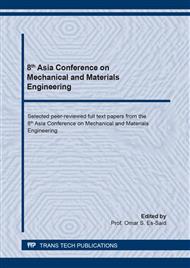[1]
T. J. Teo, G. Yang, and I. M. Chen, Compliant Manipulators,, in Handbook of Manufacturing Engineering and Technology, ed: Springer London, 2014, pp.2229-2300.
DOI: 10.1007/978-1-4471-4670-4_102
Google Scholar
[2]
N. Lobontiu, Compliant mechanisms: design of flexure hinges: CRC press, (2010).
Google Scholar
[3]
T. J. Teo, I. M. Chen, G. Yang, and W. Lin, A generic approximation model for analyzing large nonlinear deflection of beam-based flexure joints,, Precision Engineering, vol. 34, pp.607-618, (2010).
DOI: 10.1016/j.precisioneng.2010.03.003
Google Scholar
[4]
P. Wang, M. L. S. Nai, W. J. Sin, S. Lu, B. Zhang, J. Bai, et al., Realizing a full volume component by in-situ welding during electron beam melting process,, Additive Manufacturing, vol. 22, pp.375-380, 2018/08/01/ (2018).
DOI: 10.1016/j.addma.2018.05.022
Google Scholar
[5]
P. Wang, X. Tan, C. He, M. L. S. Nai, R. Huang, S. B. Tor, et al., Scanning optical microscopy for porosity quantification of additively manufactured components,, Additive Manufacturing, vol. 21, pp.350-358, 2018/05/01/ (2018).
DOI: 10.1016/j.addma.2018.03.019
Google Scholar
[6]
E. Merriam, J. Jones, S. Magleby, and L. Howell, Monolithic 2 DOF fully compliant space pointing mechanism,, Mechanical Sciences, vol. 4, pp.384-390, (2013).
DOI: 10.5194/ms-4-381-2013
Google Scholar
[7]
E. G. Merriam, J. E. Jones, and L. L. Howell, Design of 3D-Printed Titanium Compliant Mechanisms,, in Proceedings of the 42nd Aerospace Mechanisms Symposium, 2014, pp.169-173.
Google Scholar
[8]
E. G. Merriam and L. L. Howell, Lattice flexures: Geometries for stiffness reduction of blade flexures,, Precision Engineering, vol. 45, pp.160-167, (2016).
DOI: 10.1016/j.precisioneng.2016.02.007
Google Scholar
[9]
H. S. Fiaz, C. R. Settle, and K. Hoshino, Metal additive manufacturing for microelectromechanical systems: Titanium alloy (Ti-6Al-4V)-based nanopositioning flexure fabricated by electron beam melting,, Sensors and Actuators A: Physical, vol. 249, pp.284-293, (2016).
DOI: 10.1016/j.sna.2016.08.029
Google Scholar
[10]
M. T. Pham, T. J. Teo, S. H. Yeo, P. Wang, and M. L. S. Nai, A 3D-printed Ti-6Al-4V 3-DOF compliant parallel mechanism for high precision manipulation,, IEEE/ASME Transactions on Mechatronics, vol. 22, pp.2359-2368, (2017).
DOI: 10.1109/tmech.2017.2726692
Google Scholar
[11]
M. T. Pham, T. J. Teo, S. H. Yeo, P. Wang, and M. L. S. Nai, Synthesis and Evaluation of A High Precision 3D-Printed Ti6Al4V Compliant Parallel Manipulator,, IOP Conference Series: Materials Science and Engineering, vol. 280, p.012040, (2017).
DOI: 10.1088/1757-899x/280/1/012040
Google Scholar
[12]
M. T. Pham, S. H. Yeo, T. J. Teo, P. Wang, and M. L. S. Nai, Design and Optimization of a Three Degrees-of-Freedom Spatial Motion Compliant Parallel Mechanism With Fully Decoupled Motion Characteristics,, Journal of Mechanisms and Robotics, vol. 11, pp.051010-8, (2019).
DOI: 10.1115/1.4043925
Google Scholar
[13]
P. Wang, J. Song, M. L. S. Nai, and J. Wei, Experimental analysis of additively manufactured component and design guidelines for lightweight structures: A case study using electron beam melting,, Additive Manufacturing, vol. 33, p.101088, 2020/05/01/ (2020).
DOI: 10.1016/j.addma.2020.101088
Google Scholar


